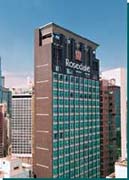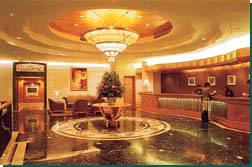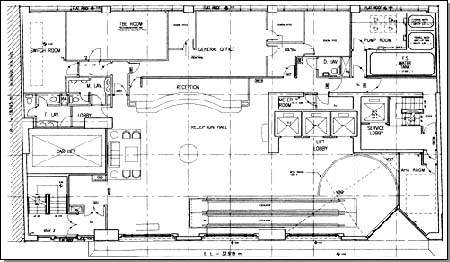| August
2001 |

 |
|
|
Rosedale
on the Park
Standing
out
In a city renowned for its hospitality
industry, how does a small and new hotel distinguish itself from
its many established competitors?
This question was very much on the
mind of the Paul Y-ITC Group when it bought a 611 sq m site in Causeway
Bay in 1997. The company saw the site's potential as a hotel development
because of its location in Hong Kong's premier shopping district
and, given its size, decided it would be a boutique hotel that would
offer guests a uniquely 21st century experience.
 The project is an unusual one in that the company, as a developer
with subsidiaries involved in all aspects of the construction business,
is able to make the project an entirely family affair. The group
acted as project manager and designer while Paul Y-ITC General Contractors
Ltd undertook construction of the hotel. Paul Y-ITC (E&M) Contractors
Ltd was responsible for the building services installation and Paul
Y-ITC Interior Contractors Ltd handled the interior fitting-out.
Even the demolition of the building that previously occupied the
site was carried out by a subsidiary.
The project is an unusual one in that the company, as a developer
with subsidiaries involved in all aspects of the construction business,
is able to make the project an entirely family affair. The group
acted as project manager and designer while Paul Y-ITC General Contractors
Ltd undertook construction of the hotel. Paul Y-ITC (E&M) Contractors
Ltd was responsible for the building services installation and Paul
Y-ITC Interior Contractors Ltd handled the interior fitting-out.
Even the demolition of the building that previously occupied the
site was carried out by a subsidiary.
¡@¡@Given the degree of control
the company had over the project, from start to finish, it seized
the opportunity to, first of all, showcase a fast, safe and efficient
construction technique and, secondly, introduce what must be the
industry's most hi-tech hostelry.
Construction
According to Edmond Mok, managing director of Paul Y Properties
Group Ltd, the group has long been aware of the problems affecting
the Hong Kong construction industry: building processes are not
environmentally-friendly; workmanship is poor; and skilled workers
are hard to come by.
The typical building
project in Hong Kong involves the construction of a high rise using
timber scaffolding. Workers produce work of an uneven quality in
an uncomfortable environment which is exposed to sun and rain.
"We asked ourselves
whether we couldn't move the work into a controlled environment
like that of a factory, in order to obtain better quality work,
and felt that precasting could be the answer," Mr Mok said.
On a typical building
project the amount of precasting that can be used is subject to
the design drawn up by the architect. In this case, since the designer
and contractor belong to the same group, they were able to sit down
together to work out a design based on buildability.
"Property development
is usually carried out by people with different roles who don't
have an in-depth knowledge of each other's fields and can't take
into account each other's interest. By using our own people for
the whole project we created a synergy that enabled us to optimise
the architect's ideas through team feedback," Mr Mok explained.
The result of this approach
is a design optimised for precast construction. Apart from non-typical
elements on the top floor and the podium, the 33-storey hotel consists
of 322 standard modules with semi-precast slabs and precast facade
units.
At Paul Y-ITC's factory
in Yuen Long, the facade units, complete with bay windows, were
concreted using steel moulds that allowed the window frames to be
cast at the same time. Two types of steel moulds were used, for
casting end modules and middle modules respectively. Although they
were more expensive than timber formwork, their cost was justified
by the number of modules required, which meant they could be used
over and over again.
Ceramic tiles and glazing
were also affixed at the factory. According to Mr Mok, the standard
practice within the industry was to order six per cent more tiles
than the number actually needed, to cover wastage. However, because
the facade was factory-produced, wastage was reduced by 50 per cent,
so the contractor needed only three per cent extra.
The glazing was sealed
with silicon and subjected to waterproofing tests in the factory
before each facade unit was transported to site for installation.
Mr Mok said there was some concern about breakage when the glass
was installed so soon, but it turned out to be unnecessary because
there was no high-rise work on site which might cause damage to
the glazing.
On site, the precast
facade units were hoisted into place and fixed into position with
temporary bracing. Steel large panel formwork was then used to cast
the structural walls in situ. Once the walls had cured, precast
slabs were hoisted and positioned over the walls and facade units
to form the lower layer of the floor slab. These precast slabs serve
a dual purpose, both as formwork for slab construction and, together
with the cast in situ upper layer, part of the permanent structure.
The advantage of this method, of course, is that both time and labour
were saved because there was no need to dismantle the formwork.
For non-structural wall
partitions, the contractor used a dry wall which, because of its
lightweight, reduced the dead load imposed on the structure. The
dry wall panels came with a smooth wall finish which eliminated
the possibility of uneven quality associated with the wet trades.
A thin coat of plaster was all that was needed to finish the panels.
For bathrooms, the smooth finish facilitated the dry installation
of bathroom tiles using adhesives.
With the air ducts sealed
after four to five floors of construction, an enclosed, all-weather
working environment was created in which the fitting-out contractor
could work in complete safety.
The risks associated
with working outdoors are usually taken into account in the tender
price of contractors. Since these risks were effectively removed
through the method of construction used, Mr Mok said the company
was able to persuade sub-contractors to reduce their prices, thus
saving 3-4 per cent of cost.
This method of construction
was not only safe, but also fast. The hotel took just 19 months
to build, from construction of the ground beam to the granting of
the occupation permit.
The design
Clever use of a small footprint was made to fit all facilities
into a small hotel.
The 274-room Rosedale
on the Park has two food and beverage outlets, a number of function
rooms and a basement car park. Most of the ground floor is set aside
for vehicular access. A revolving platform allows cars to enter
and exit from the same point while access to the basement carpark
is provided by two heavy duty lifts, as there is not enough space
to accommodate a ramp.
Since much of the ground
floor is given over to vehicular access, the lobby is raised to
the first floor, reached via a ground floor entrance addressed by
a copper rose motif over the door. Overlooking the escalator which
transports visitors between the ground and first floors is a sculpture
with two geese, one looking down at the ground floor entrance and
the other seemingly admiring a rose relief set in the double-height
wall opposite the entrance. Mr Mok himself made a trip to the UK
to select the sculpture, an indication of the close involvement
of Paul Y-ITC's management in every detail of the project.
Different types of artworks,
from murals to paintings, were commissioned or carefully selected
to enhance the interior. In the coffee shop, reproductions of abstract
masterpieces echo the bright, jazzy atmosphere of a space enlivened
by the geometry of lines and curves. Original prints line the walls
everywhere; even the restrooms. Many are abstract prints with a
touch of gold that ties in with the hint of opulence that reveals
itself in the gold-leafed coffered ceiling and sombre green drapes
of the lobby and the mirror panelling of the lift lobbies.
Two colour schemes are
selected for the guestrooms: an informal peach and a more regal
dark brown with touches of gold. The facilities, while simple, are
meticulously planned with the aim of making the hotel appealing
to a wide range of guests. For example, each bed has another one
tucked away underneath it. This makes it convenient for families
with children to set up extra beds; at the same time, it saves the
need to reserve precious space for a storeroom to hold spare beds.
The modular design of
the hotel not only facilitated construction, but also enhances the
flexibility of the layout. In suites made up of two modules, the
second module is turned into a living area complete with sofa, dining
table and a small pantry with refrigerator and a microwave, facilities
designed to attract long-term guests in search of a serviced apartment
setup. Suites comprising three modules feature a living area between
two guestrooms, making them suitable for large families as well
as business people who prefer to have a space where they can work
and hold meetings in private.
Externally the earthy-coloured
tiles of the precast facade are set off by a podium clad in dark
green granite. Mr Mok said the dignified hue was chosen because
the hotel was designed to appeal to both business people and leisure
travellers. The building is topped by a symbol of the hotel and
its name, both of which are floodlit at night to give the hotel
high visibility, particularly from the direction of the Island Eastern
Corridor.

first floor plan
Rosedale's hi-tech features
The hotel's literature describes Rosedale as a cyber boutique hotel,
for a good reason. According to Mr Mok, the information technology
framework was given due consideration during the planning stage
of the project. The wiring necessary for the IT provisions was routed
through wire conduits provided in the structure so that very little
wire was exposed. At the same time, the hotel is already moving
towards wireless telecommunications.
¡@¡@Wireless Internet access is
already available in the sky lounge and the service is to be extended
to the lobby and coffee shop, Sonata. The function rooms are equipped
for teleconferencing and, in the future, guests will be able to,
say, check their email over breakfast or work anywhere inside the
hotel.
¡@¡@Each guestroom is equipped
with broadband access so that road warriors can stay in touch with
head office in the comfort of their own rooms and parents can take
time out to check their stock portfolio after returning from a trip
to Ocean Park. Each guestroom is also provided with a digital cordless
phone which works anywhere within the hotel. A comprehensive antenna
system ensures uninterrupted roaming within the hotel, which means
a guest does not have to miss a call just because she has gone to
the sky lounge for a drink, for example.
¡@¡@In addition to the cordless
phone for use within the hotel, Rosedale also provides mobile phones
for guests. If they are regular visitors, they can keep the numbers
assigned to them so that they can always be reached on those numbers
whenever they are in Hong Kong. For guests travelling without a
notebook computer who want Internet access nonetheless, web phones
consisting of an integrated phone and browsing station with pull-out,
full-sized keyboard can be provided.
¡@¡@If that is not enough, the
hotel has also tied up with 3Com to offer Kerbango, a broadband
radio system which allows guests to tune into any one of 5,500 radio
stations on the web.
¡@¡@Internet reservation is now
possible for many hotels, but Rosedale's system is more advanced
than most. Unlike the majority of systems, which accept reservations
for a number of guestrooms allotted for Internet booking, Rosedale's
Internet booking system handles reservation in real time.¡@¡@"Our
reservation system is completely open to the Internet," said
the hotel's technology consultant Terence Ronson. "A guest
can book the last room available for Internet room rates, wherever
he or she is, 24 hours a day. Another innovative feature called
Hotel in My Hand has also been developed with the business traveller
in mind. This is a small file available in either Palm database
or Windows CE format which guests can download before setting off.
In addition to essential information about the hotel and Hong Kong,
the file contains e-coupons from local merchants; a graphical taxi
card to help guests who do not know Chinese get around; and useful
telephone numbers.
¡@¡@Technology is not confined
to the front end of the hotel. To optimise inventory management,
supplies are bar-coded. By helping the hotel keep track of the supply
situation at all times, the system reduces the amount of stock held
while ensuring guests will not be deprived.
¡@¡@Rather than having staff clock
in and out in the traditional way, the hotel introduced a thumbprint
identification system which allows employees to register on and
off duty as well as enter the staff cafeteria by presenting their
thumbs and entering a personal identification number. In case someone
cuts his or her thumb by accident, the fingerprints of both thumbs
are encoded. The timekeeping system is integrated with the hotel¡¦s
human resources system, to facilitate payroll management.
¡@¡@Many of the hi-tech features
are incorporated not only to meet the needs of new millennium travellers,
but also to make the hotel's operation more environmentally-friendly.
For example, Internet reservations are confirmed by email, hotel
information is made available on the Internet and for the Palm and
Windows CE platforms; suppliers are encouraged to adopt electronic
invoicing systems.
¡@¡@Rosedale invested HK$7 million
in its hi-tech provisions. Given its linkage with the Best Western
franchise, there is a good chance it will attract a fair share of
tech-savvy travellers. Together with the cost savings achieved through
improved efficiency back-of-house, it is money well spent. And for
all its hi-tech sophistication, the staff were trained and the cyber
boutique hotel was ready for soft opening in just 60 days, rather
than the usual four to five months.
Paul Y-ITC
Construction Holdings Ltd
developer/owner
Paul Y-ITC General Contractors Ltd
design and build contractor
Cartesian Architects Ltd
architect/authorised person
|

 The project is an unusual one in that the company, as a developer
with subsidiaries involved in all aspects of the construction business,
is able to make the project an entirely family affair. The group
acted as project manager and designer while Paul Y-ITC General Contractors
Ltd undertook construction of the hotel. Paul Y-ITC (E&M) Contractors
Ltd was responsible for the building services installation and Paul
Y-ITC Interior Contractors Ltd handled the interior fitting-out.
Even the demolition of the building that previously occupied the
site was carried out by a subsidiary.
The project is an unusual one in that the company, as a developer
with subsidiaries involved in all aspects of the construction business,
is able to make the project an entirely family affair. The group
acted as project manager and designer while Paul Y-ITC General Contractors
Ltd undertook construction of the hotel. Paul Y-ITC (E&M) Contractors
Ltd was responsible for the building services installation and Paul
Y-ITC Interior Contractors Ltd handled the interior fitting-out.
Even the demolition of the building that previously occupied the
site was carried out by a subsidiary.